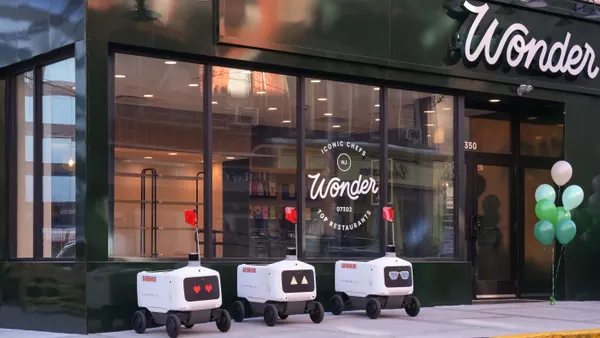Dive Brief:
- Uber Eats is rolling out redesigned versions of its consumer-facing app and mobile website in 16 cities, including San Francisco, Washington, D.C. and Miami, according to a company release.
- Delivery customers in these markets will have access to new features designed to resolve issues with delays and order cancellations, and will now be able to contact couriers directly before their order is picked up. The platform has also enhanced the tracking experience, adding a five-section tracking bar that features animated illustrations to keep diners up to date on their order's status throughout different stages of the delivery journey. The app also displays "Latest Arrival By" time in addition to delivery ETAs, as well as the driver's name, an Uber Eats spokesperson told Restaurant Dive.
- Uber Eats designers met with hundreds of eaters, delivery and restaurant partners across nine countries to see how th app could be improved, and received consistent feedback that users wanted more information about the delivery flow, according to the company.
Dive Insight:
Uber Eats is wise to bring more transparency to its food delivery tracker through colorful, aesthetically pleasing animations, including a stirring whisk and mixing bowl to signal the restaurant is "preparing your order" and delivery bags full of food to announce the order's arrival. These additions deliver on consumer demand for dining experiences, and could help differentiate the platform's offering from upstream rivals DoorDash and Grubhub.
The addition of the five-step tracking bar — which includes order confirmation, order preparation, notification of the delivery partner en route, order pick-up and arrival — could also help ease user frustration over unexpectedly long wait times and improve courier accountability.
"Sometimes confusion over a delivery can lead to customers blaming a courier or a restaurant for their experiences. By bringing that information upfront, we hope to provide better accountability and transparency for our customers, restaurant partners and couriers," an Uber Eats spokesperson told Restaurant Dive via email. "We hope that couriers will now have a greater understanding of all that goes into the delivery process from start to finish."
This update could benefit Uber Eats' partner restaurants as well, as 62% of diners blame both third-party aggregates and eateries for late or cold orders, according to a recent Zion & Zion study.
Whether or not these changes are enough to poach delivery customers from industry rivals is unclear. DoorDash and Grubhub still have a healthy lead over the newcomer, which came to market just over three years ago, with 27.6% and 26.7% share of consumer food delivery spend, respectively, according to an Edison Trends report. Comparatively, Uber Eats stands at 25.2%, but boasts the largest number of food orders in the industry, with just under 30% of market share. The company has the lowest price per transaction compared to its competitors, however.
Still, the delivery platform is gaining momentum. Between 2016 and 2019, it grew from 5% of the U.S. food delivery market to 25%, and CEO Dara Khosrowshashi claims it's on pace to deliver $10 billion worth of food this year, compared to around $6 billion in 2018.
If its design improvements do drive more traffic to its app, it could result in meaningful customer loyalty. And with a newfound emphasis on customer service, this might just be the very component it needs to surpass Grubhub and DoorDash.










